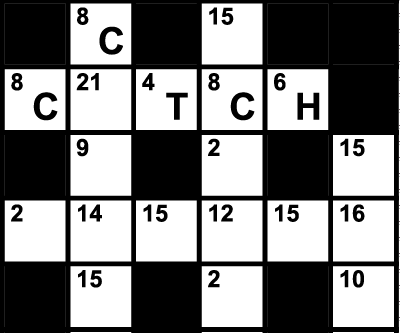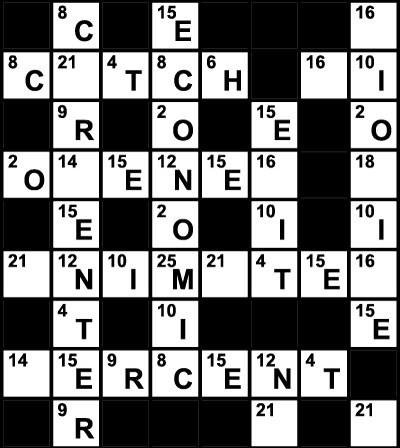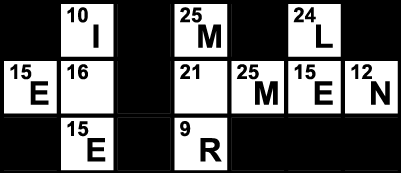Try our Word Search Maker!
Try our Word Search Maker!
Also known as Code Breakers, Code Crackers, Cross Reference, Keyword and Starhunt, Codewords are one of the most popular word puzzles.
If you are given any starting letters the first thing to do is fill in all other occurrences of those letters, which will be where the same numbers occur in the grid as those given to you.
It is helpful to make sure any letters you know are entered into the answer grid and crossed off the list to keep track of the letters found as this will help you later.
If you haven't been given any starting letters then you will need to start with advanced analytical methods which will be discussed further on.
Now that you have filled in all the letters you know are correct, are there any words that have only one possible answer based on the letters already known? This is the obvious place to start as it will immediately give you one or more letters that you can fill in where they appear elsewhere in the grid.
For some words it there will be no doubt which letters are missing and you can complete the word with confidence. However it is wise to be cautious and pause for a moment to consider whether there may be any possibilities you have overlooked. There are many words out there you probably didn’t even know existed!

In the example above, we’ve been given the letters “C”, “T” and “H” to start us off. The word we can make next is surely “catch”, right? But did you know that “cutch” is a tannin extract from the bark of a mangrove tree? Or even “cwtch”? A Welsh hug (or cupboard!).
If you are unsure you will perhaps need to leave it until later and look elsewhere in the grid or think ahead and cross-reference it with the surrounding words. Though we can probably rule out cwtch as that would mean we would have to find another word going down also beginning with “CW” which is a very uncommon letter combination.

Now more of the grid has been filled in we can be certain whether it is catch or cutch even though we still haven’t found the “A” or “U” yet. This would either make the intersecting word CAR_ENTER or CUR_ENTER depending on which letter we used, and combining this with _ERCENT which shares a common missing letter we can be without doubt that the correct word is “catch” which gives us “carpenter” and “percent”.
Words that have unusual letter combinations, or a high percentage of known letters will have the fewest number of possibilities and it’s worth concentrating on these first. Long words will have more restrictions too but it can be harder to visualise words that will fit.
We could have also looked elsewhere in the grid where the code number 21 appeared and if we could determine that the letter “U” in anyone of those squares would have prevented a valid word being formed then we can safely discount 21 being the letter “U” and safely concluded it could only be the letter “A”.

In this case we know that 21 is either “A” or “U” and here we know that we could make the word “amen” or “omen” but not the word “umen” so 21 cannot be the letter U and we can conclude the word is amen along with catch as “cotch” is not a valid word.
Finding different words which are coded with the same number can help when there are multiple options. By considering a letter that will fit all of them, particularly if it would complete or narrow down two or more words, it might be possible to find the correct letter or limit it to just a handful of likely candidates.
For example, if each of these had the same coded missing letter, P_ST, GR_W and M_SS, you know that the missing letter can only be E or O, whereas if you took each one in isolation it could be A, E, I, O or U.
Knowing that only two or three letters can code a particular number may help you determine another word in the grid which also contains that coded letter.
There will be times when you are left with too few letters, and too many gaps and possibilities to determine any further words, unless you happen to have a supercomputer for a brain! The hardest part is often early on because there are so few letters in the grid and more possibilities to narrow down for each word. One word, however, can sometimes be the key to unlocking the whole puzzle.
Looking at the letter frequencies and patterns to work out a few best guesses, or where the vowels might be, to see if they will fit in with the rest of the grid is a common strategy in this scenario. If you haven’t been given any starting letters for the puzzle, this is the place where you’d start.
An often used technique is to look at the number of times each letter occurs in the puzzle. The vowels are most likely to occur most frequently, with “E” usually being the most common, followed by “A” and “O”. If you want a method to remember how frequently each letter appears in the written or spoken English language, remember the phrase etaoin shrdlu as an approximate order.
However, this is based on natural usage of English, which contains a lot of common words like the, there, their, then, thank, than, that, them and they, which raises the number of times you will see the letters “T” and “H” in particular. Crossword type puzzles don’t often use these filler words and the distribution of letters can be somewhat different to that found in the real world. Combine that with the puzzle setter sometimes being sneaky and avoiding common letters and combinations and you can find yourself walking into a dead end!
Analysis of the frequency of dictionary words gives a slightly different order, eairto nslcup, and is probably more accurate order of frequency for crossword type puzzles. If you include plurals and suffixes it changes again to eisarn tolcdu. This method isn’t always reliable but it can often yield enough clues to make progress.
Conversely, you can look at those letters with the least frequency, with Q,Z,J and X being the usual candidates. If you have already found the U, it can be quite easy to spot the Q as it will be low frequency and nearly always precedes the U.
Certain combinations of letters within a word can be a useful hint that can lead you in the right direction. Looking for double letters in words or repeating patterns can vastly help you reduce possibilities or suggest more likely words.
“LL” is the easily the most frequent double with “SS” and “EE” next, then “OO”, “TT”, “FF”, “PP” and “RR” a fair way behind. “ZZ” is very uncommon in English usage, appearing in only 0.25% of valid words, but as setters must place an obligatory Z into the grid, and 6% of “Z” words contain “ZZ”, it will be a bit more common than you might think!
There are some doubles that will very rarely or never appear though like “QQ”, “YY”, “JJ” and “WW”, along with other letter combinations that rarely appear such as “JK”, “FP”,”VC” and so on.
Endings are another possible clue. The letter S will often appear where the ends of two plurals intersect. If you already have one or more of the letters near the end of a word, it may lead to suggestions of common suffixes that will fit such as, -TION, -ING, -ATE, -EST, -FUL, -IVE, -LY, -MENT, -IST, -ITY and -ER. You may also find repeating patterns that occur at the end of several words, but many setters will often try to minimise repetition of letter combinations, particularly word endings - they don’t want to make things too easy!
There are certain letter combinations that are less likely, so if you have the letters M_N, you will know that it’s most likely that a vowel will fill the gap. In this case there are over 12,000 words with the sequence M_N and only 38 of them have a consonant between the M and N, most of which are compound words such as “thumbnail” or suffixed words like “dampness”.
However there are some common patterns where the opposite holds true. There are 1,900 words containing the pattern S_H and 1,800 of them have a consonant between the S and H to make a triple consonant, which is usually either “SPH”, “SCH” or “STH”. That means you know there is a good chance the middle letter will be H, S or T.
The same can be true of vowels too. The pattern A_E appears in over 23,000 words but only 37 of them form a triple vowel pattern, with T being by far the most common letter found between A and E.
As you become more experienced and as your vocabulary grows you will get a feel for what letter combinations go together most frequently and identify where there is a very limited choice, which helps you narrow your options down.
Like some combinations are more likely than others, there are popular positions for certain letters within words. When Q makes an appearance it is at the beginning of the word 33% of the time and usually followed by a U. J appears at the beginning 55% of the time. G appears at the end in 32% of words containing a G, and Y appears at the end 50% of the time.
You can also be sure that certain letter combinations won’t appear at the start of a word, such as, CK but is a likely combination when C is the penultimate letter.
Knowing where letters and combinations tend to appear in words can help you work out some likely candidates to test.
Once you have an idea what a letter or sequence of letters may be, it is important to cross reference it with the other occurrences and the letters surrounding them to see if any words suggest themselves or rules out your idea. The more you can narrow it down the better. This is where it helps to have a brain like that of a chess grandmaster, able to think several moves ahead and store all the likely permutations in your head! Or alternatively you can use a pencil to tentatively write in what you think a letter may be (or even several letters in one square) and start looking for ideas that seem to work based on your educated guesswork.
Don’t forget that every letter of the alphabet must be contained somewhere within the puzzle. You can use that to your advantage knowing that once you’ve used it, even tentatively, it may exclude it from being an option elsewhere and reduce the number of possibilities for a word.
If you get really stuck you may have to start systematically trying different possibilities for letters and rubbing out your efforts (so write lightly in pencil!) until you get something that looks promising.
The real fun is in being able to solve a puzzle with no outside help so you can be proud of your achievement on completing the puzzle all by yourself. We all get stuck or frustrated with puzzles sometimes and you can either leave it, start another one, and come back to it another day - a word might reveal itself with fresh eyes, or you may have made a mistake you hadn’t spotted - or you can get a little bit of assistance to get you out of that rut.
There are two ways you can give yourself a bit of assistance without spoiling the fun too much. If your vocabulary isn’t the best then there may be some words that only have one possible answer in the grid that you have missed, in which case a “crossword solver” can be a great tool to get you going again. The long words or unusual letter combinations are often the easiest words to determine and will give you the most help. There are plenty of crossword solvers available on the internet, where you enter the letters and blanks, and it will tell you what words would fit into that pattern. If there is only one option, then you can enter that word and see if that gives you enough help to finish the puzzle. Even if there are two or three options you still may be able to deduce which one is the correct one by looking ahead and seeing which one will fit in with the intersecting words.
If you have a good vocabulary and are stuck because there are too many possibilities to narrow down you will be better served by giving yourself a helper answer or letter. You can do this by having a quick peak in the back of the book at the solutions and try to limit yourself to looking at just one extra letter or word.